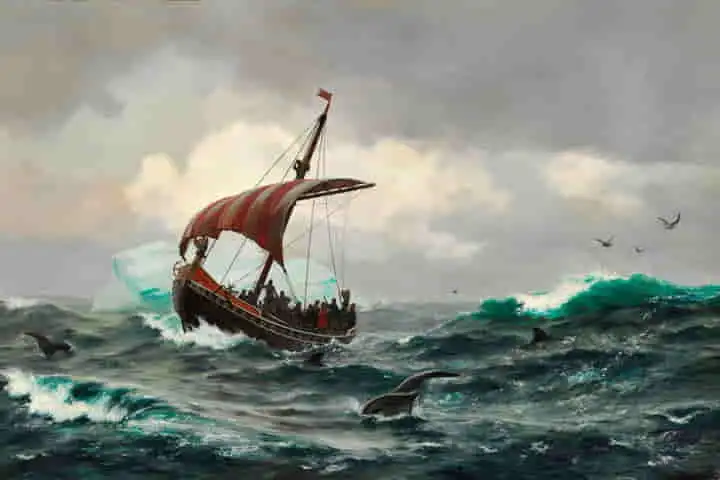

The mighty Vikings had to leave Greenland because of climate change that flooded their homes and fields (Pic. Courtesy Twitter/@HistoryofViking)
<p>
<strong>Feared around the world, the Vikings struck terror and fright in people and countries, yet these same mighty combatants had to kneel before the diktat of nature and climate change.</strong></p>
<p>
According to a report in livescience.com, recently researchers discovered that growth in ice sheet and rise in sea level which resulted in flooding of the coasts that inundated farms of the Norse, eventually made the Vikings in the 15th Century leave Greenland.</p>
<p>
It was near about 985 AD that the first Vikings centre in southern Greenland came up when Erik Thorvaldsson who was also known as &quot;Erik the Red&rdquo;, undertook a voyage to the region. This Norwegian-born explorer was exiled from Iceland following which he sailed to Greenland.</p>
<p>
This pioneer was followed by other Viking settlers who formed groups in Eystribygg&eth; or Eastern Settlement and Vestribygg&eth; or Western Settlement, which flourished for centuries.</p>
<p>
<strong>Also read: <a href="https://www.indianarrative.com/science-news/new-study-suggests-twilight-zone-between-wakefulness-and-sleep-triggers-creativity-136514.html">New study suggests twilight zone between wakefulness and sleep triggers creativity</a></strong></p>
<p>
Before the arrival of the Vikings, according to the University of California, Riverside, Greenland was populated by people of the Dorset Culture, who were indigenous community who had predated the Inuit people in the Arctic.</p>
<p>
It was somewhere in the 15th Century that the Norse community in the area disappeared from the archaeological record. In the past, the scientists had proposed that they abandoned Greenland because of change in climate and economic shifts. New discoveries at present indicate that the rising seas had played a vital role in this as it submerged miles of coastline as per the data which was presented at the American Geophysical Union (AGU) annual conference, held in New Orleans and online.</p>
<p>
The period between the 14th and 19th Centuries cooler temperatures were experienced in North America and Europe. This period is known as the Little Ice Age. The prevalence of such chilly conditions saw the vast blanket of ice covering a large area of Greenland &ndash; the Greenland Ice Sheet &ndash; becoming even bigger. This was stated in a presentation by Marisa Julia Borreggine at the AGU Conference.</p>
<p>
Borreggine is a doctoral candidate in the Department of Earth and Planetary Sciences at Harvard University.</p>
<p>
The advancement of ice sheet made it heavy on the substrate underneath, resulting in rendering the coastal areas more vulnerable to flooding, said Borreggine. Simultaneously, the increased gravitational attraction between huge masses of sea ice and the expanding ice sheet pushed more seawater over Greenland&#39;s coast. The working of these two processes together led to flooding of the coastline on a widespread scale and as per Borreggine <a href="https://www.livescience.com/agu-floods-drove-vikings-from-greenland?utm_source=SmartBrief&amp;utm_medium=email&amp;utm_campaign=368B3745-DDE0-4A69-A2E8-62503D85375D&amp;utm_content=3C6E0550-25B8-4AC1-B00A-7E238D7AF254&amp;utm_term=c2029947-e980-4274-bc11-2f4c117930b6">&quot;exactly where the Vikings</a> were settled&rdquo;.</p>
<p>
This hypothesis was tested by the researchers and scientists by modelling estimated growth in ice in southwestern Greenland over the 400-year period of Norse occupation and adding those calculations to a model showing rise in sea level during that time. Further, maps of known Viking sites were analysed to find how the study&rsquo;s finding fitted with the archaeological evidence that showed the Viking presence in Greenland come to an end.</p>
<p>
The models reflected that the rising seas in the Greenland area would have inundated Viking settlements by nearly 16 feet or five metres in the period from 1000 to 1400. This Borreggine said would have affected about 54 square miles or 140 square kilometres. As per the models, the land that Vikings used for agriculture and for grazing their cattle would have been under water.</p>
<p>
<strong>Also read: <a href="https://www.indianarrative.com/science-news/mosquito-hunting-fish-tamed-by-robotic-cousin-to-behave-itself-136100.html">Scientists use robots to rein in rogue mosquitofish</a></strong></p>
<p>
Besides, the rise in sea level, other factors too contributed in leading to Vikings quit Greenland. These included social unrest and depletion of resources which in tandem with climate change may have caused the Vikings to leave their homes permanently Borreggine said.</p>
<p>
Summing up the study&rsquo;s findings, Borreggine said: &quot;A combination of climate and environmental change, the shifting resource landscape, the flux of supply and demand of exclusive products for the foreign market, and interactions with Inuit in the North all could have contributed to this out-migration. Likely a combination of these factors led to the Norse migration out of Greenland and further west.&quot;</p>
Taiwan's Ministry of Foreign Affairs has rejected the joint statement issued by China and Bangladesh…
The Fourth edition of the bilateral Tri-Service India-US Humanitarian Assistance and Disaster Relief (HADR) Exercise,…
External Affairs Minister S Jaishankar on Monday welcomed Netherlands Foreign Minister Caspar Veldkamp to India…
Despite a temporary injunction against the dismissal of Israel Security Agency (Shin Bet) chief Ronen…
Union Home Minister Amit Shah on Monday highlighted the Modi government's achievements in the health…
The e-commerce sector in India is expected to witness the highest salary increments in 2025,…